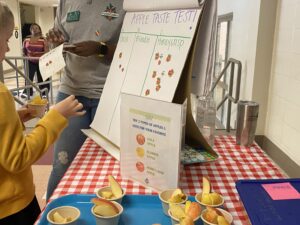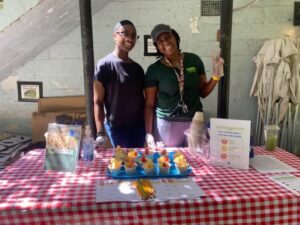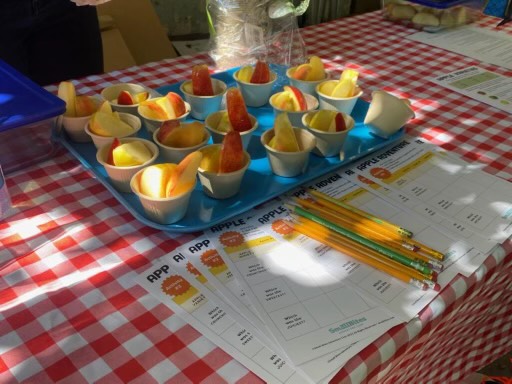By Tatiana Gonzalez, Wylde Center Educator
Apples have become a trademark symbol of healthy eating, suggesting that this colorful fruit will fix all your ailments. While a nutritious diet requires more than just ‘an apple a day’, we are honoring apples as September’s Harvest of the Month in celebration of all the abundance and beauty it has to offer during this late summer and early autumn season. This month, we are honoring apples through learning more about their history, planting them in the garden, and hosting a school-wide apple taste test.
Apple’s Global History:
Like most fruits and vegetables, apples have an extended life history that tells a story of the connection and interaction between humans and plants. With human intervention, apples traveled the world and grew to be loved by a variety of different locations and cultures.
- Botanical Information: Apples are a member of the rose family [Rosacea], sharing a family with pears, peaches and cherries. The modern apple, which goes by the scientific name of Malus domestica, has evolved from multiple generations of hybridizations of the wild apple tree, known as Malus sieversii.
- Birthplace of Apples: The apple’s place of origin is from the mountains of Kazakhstan, a country in central Asia east of the Caspian Sea. Apples traveled along the ancient trade routes of the Silk Road, making their way around the world starting with central Asia, to Egypt, to Rome, to Northern Europe and beyond.
- Cultural Significance: Apples have cultural heritage in multiple parts of the world. Apple symbolism has been found from golden apples providing immortality within Greek and Norse mythology to the association of apples as a symbol of peace in Chinese culture. They are also featured along with honey in the Jewish New Year, Rosh Hashanah, as a symbol of hope for a sweet year ahead.
Planting Apple Trees in School Garden:
When asking students what they would like to plant in their school garden, one of the top requests is always, “apples!” Having an apple tree at school is a great way for students to make connections about how fruit grows and have access to fresh fruit at school. However, planting an apple tree comes with a few more challenges than planting seeds in a garden bed. We created this guide to help you feel more confident, or have more questions about planting apple trees at your schoolyard.
There are several important things to consider when thinking about planting apple trees at home or in a school garden. These include the size and location of the plot, deciding which variety of apple tree works best for your region, and how far apart you should plant your trees. Check out our Guide to Planting Apple Trees at Your School Garden for more information and funding resources.


[FoodCorps member Arielle hosting a taste test at Toomer Elementary School]
Apple Taste-Test:
There are so many different apple varieties to choose from – and one of the best ways to enjoy apples this season is to simply eat them raw! That is why, for our taste-test of the month, we are having a comparison taste test where students try three different types of apples and vote for their favorite.
- Select three different varieties of apples: For our taste tests we are using HoneyCrisp, Gala and Blondie, but choose whichever apples are most accessible. Once the three different varieties are selected, place one slice of each apple into a sample cup for each student.
- Ask students to observe the similarities and differences of each type of apple: Encourage students to use all of their five senses. Ask students to share their observations about the different colors, the different textures, the different scents of each apple.
- Taste: Invite the students to taste it all together!
- Vote: Lastly, invite the students to vote on which apple variety was their favorite. This can be done through providing markets or stickers, etc. At the end of the day, there will be concrete data on which apples students enjoyed the most, which can inform what kind of apple tree may be best suited for the school garden.


[Our FoodCorps members Arielle and Chris serving apple slices to Fall Campers at Oakhurst Garden]
In pursuit of supporting local farmers and enhancing sustainability efforts, the Wylde Center purchased apples of three different varieties from BJ Reece Orchards located in Ellijay, GA. This will result in over 5000 servings of apples, which will be served to students in Atlanta Public Schools and City Schools of Decatur this September!
—————————–
Since 1997, the Wylde Center has been dedicated to providing outstanding hands-on environmental education experiences for students throughout the Atlanta area. Our interactive classes are led by trained and enthusiastic environmental educators. As students encounter our gardens, streams, and woodlands, they learn to think critically, creatively, and responsibly about the world around them. Programs Align with current grade level Georgia Standards of Excellence. Book your 2023-2024 school programs here.
Sign-up for our Farm to School Newsletter to receive garden tips, recipes, lesson plans, and grant opportunities!
Sources:
- https://historicsites.nc.gov/all-sites/horne-creek-farm/southern-heritage-apple-orchard/apple-history/origins-apples
- https://www.nationalgeographic.com/culture/article/history-of-apples
- https://ec.europa.eu/programmes/erasmus-plus/project-result-content/273d0f04-3c91-49da-a490-736b006c209c/CYPRUS_Symbolism_of_the_Apple.pdf
- https://extension.umn.edu/fruit/growing-apples
- https://www.thetreecareguide.com/5-fruit-trees-for-usda-plant-zone-7/
- https://apples.extension.org/understanding-apple-tree-size-dwarf-semi-dwarf-and-standard/
- https://extension.uga.edu/publications/detail.html?number=C740&title=home-garden-apples
- http://extension.msstate.edu/publications/basic-grafting-techniques-0

